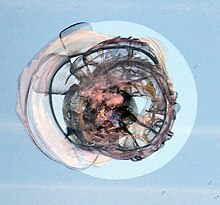Safety glass

Safety glass is
These three approaches can easily be combined, allowing for the creation of glass that is at the same time toughened, laminated, and contains a wire mesh. However, combination of a wire mesh with other techniques is unusual, as it typically betrays their individual qualities. In many developed countries[
Toughened glass

Toughened glass is processed by controlled
As a result of its safety and strength, tempered glass is used in a variety of demanding applications, including
Laminated glass

Laminated glass is composed of layers of glass and plastic held together by an interlayer.[8] When laminated glass is broken, it is held in place by an interlayer, typically of polyvinyl butyral (PVB), between its two or more layers of glass, which crumble into small pieces. The interlayer keeps the layers of glass bonded even when broken, and its toughening prevents the glass from breaking up into large sharp pieces.[9] This produces a characteristic "spider web" cracking pattern (radial and concentric cracks) when the impact is not enough to completely pierce the glass.[10]
Laminated glass is normally used when there is a possibility of human impact or where the glass could fall if shattered.
Wire mesh glass
Wire mesh glass (also known as Georgian Wired Glass) has a grid or mesh of thin metal wire embedded within the glass. Wired glass is used in the US for its fire-resistant abilities, and is well-rated to withstand both heat and hose streams. This is why wired glass exclusively is used on service elevators to prevent fire ingress to the shaft, and also why it is commonly found in institutional settings which are often well-protected and partitioned against fire.[12][failed verification] The wire prevents the glass from falling out of the frame even if it cracks under thermal stress, and is far more heat-resistant than a laminating material.
Wired glass, as it is typically described, does not perform the function most individuals associate with it. The presence of the wire mesh appears to be a strengthening component, as it is metallic, and conjures up the idea of rebar in reinforced concrete or other such examples. Despite this belief, wired glass is actually weaker than unwired glass due to the incursions of the wire into the structure of the glass. Wired glass often may cause heightened injury in comparison to unwired glass, as the wire amplifies the irregularity of any fractures. This has led to a decline in its use institutionally, particularly in schools.[13]
In recent years, new materials have become available that offer both fire-ratings and safety ratings so the continued use of wired glass is being debated worldwide. The US International Building Code effectively banned wired glass in 2006.[14]
Canada's building codes still permit the use of wired glass but the codes are being reviewed and traditional wired glass is expected to be greatly restricted in its use.[15] Australia has no similar review taking place.[16]
See also
References
- ^ "Glass." The Encyclopædia Britannica : A Dictionary of Arts, Sciences and General Literature. 9th ed. (American reprint). Vol. 10. Philadelphia: Sherman & co., 1894. 595. Print.
- ^ Frank Shuman, "Process of embedding wire-netting in glass", U.S. Patent no. 483,021 (filed: July 6, 1892; issued: September 20, 1892).
- ^ "Northeast Philadelphia Hall of Fame Announces 2012 Inductees" (press release). Mayfair Civic Association, April 26, 2010.
- ^ See:
- Édouard Bénédictus (October 1930), Glaces et verres; revue technique, artistique, pratique, 3 (18): 9.
- Jean-Marie Michel (April 27, 2012), Contribution à l'Histoire Industrielle des Polymères en France, published online by the Société Chimique de France, see Chapter A3: "Le verre renforcé Triplex", page 7.
- French patent 405,881 (registered November 25, 1909).
- ^ Hampton, Simon (15 March 2021). "Safety Glazing Glazing Glass Safety Guide For Landlord 2021". Retrieved 2021-05-16.
- ISBN 9783034615549.
- ^ "SAFETY STANDARD FOR ARCHITECTURAL GLAZING MATERIALS". www.govinfo.gov. Retrieved 2021-05-16.
- ISBN 9783764376086.
- ISBN 9781592538485.
- ISBN 9781741250510.
- ISBN 978-3-642-03313-1.
- ASIN B0046MEGF8.
- ^ Fatima, Sahar (August 25, 2014). "Industry experts question the safety of wired glass used in schools". The Globe and Mail.
- ^ Lane, Gordon. "Wired Safety Glass Deemed a Serious Hazard". Sourcable. Strata News. Retrieved 1 December 2014.
- ^ "Unsafe Wire Glass in Canada". Unsafe Wire Glass in Canada. Glassopolis. Retrieved 26 April 2016.
- ^ Lane, Gordon. "Wired Safety Glass Deemed a Serious Hazard". Sourcable. Strata News. Retrieved 1 December 2014.

